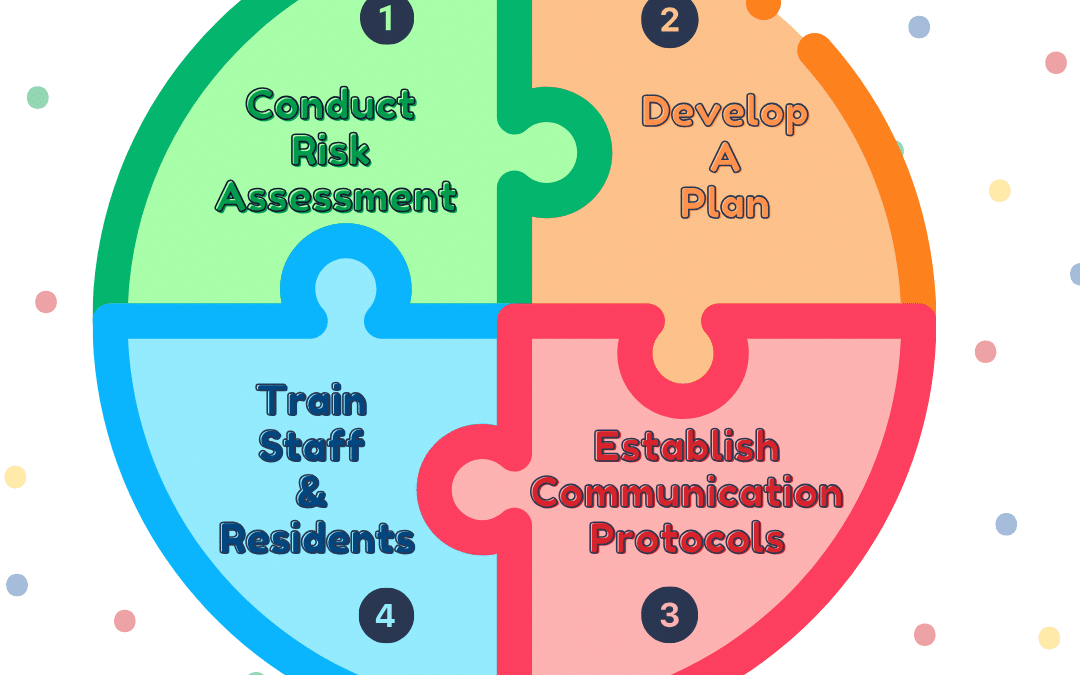In any emergency situation, having a solid emergency preparedness plan is crucial. As a property manager, it’s your responsibility to ensure that your building is as safe as possible for all of your tenants, and that means creating and continually improving upon an emergency preparedness plan. A good emergency preparedness plan should cover a wide range of potential emergencies, from natural disasters to fires to medical emergencies. It should also include evacuation routes, emergency contact information, and clear instructions for what to do in the event of an emergency.
Tailoring the Plan to Your Building and Its Occupants:
One of the most important things to keep in mind when creating or improving your emergency preparedness plan is that it should be tailored specifically to your building and its occupants. Different buildings and different communities will have different needs and priorities, and it’s important to take those into account when developing your plan. For example, if you have a large number of elderly residents in your building, you may need to have a specific plan in place for evacuating them in the event of an emergency.
Key Factors to Consider:
Here are some other key factors to consider when creating or improving your emergency preparedness plan:
1. Conduct a Risk Assessment:
Before you can create an effective emergency preparedness plan, you need to understand what the potential risks are for your building and its occupants. This might involve conducting a thorough risk assessment that takes into account everything from the building’s location to the types of hazards that are most likely to occur in your area.
2. Develop an Evacuation Plan:
Your emergency preparedness plan should include clear and detailed evacuation routes for all occupants of the building. Make sure that these routes are well marked and that everyone in the building knows where to go in the event of an emergency.
3. Establish Communication Protocols:
In an emergency situation, communication is key. Make sure that you have clear communication protocols in place for alerting residents to an emergency, notifying emergency services, and keeping everyone informed throughout the emergency.
4. Train Your Staff and Residents:
Once you have an emergency preparedness plan in place, it’s important to make sure that everyone in the building knows what to do in the event of an emergency. This might involve providing training sessions for your staff and residents, or distributing informational materials that outline the emergency procedures.
Continuous Improvement:
By taking these steps and continuously improving your emergency preparedness plan, you can help ensure that your building and its occupants are as safe as possible in the event of an emergency. Remember, emergencies can happen at any time, so it’s important to be prepared!
Tools for Emergency Preparedness Success: Crisis Communication Apps:
To enhance the effectiveness of your emergency preparedness plan, consider leveraging crisis communication apps. Here are a few examples:
1. Everbridge:
– Everbridge is a comprehensive critical communication and enterprise safety platform. It enables organizations to send alerts, notifications, and updates to employees during emergencies.
– Website: [Everbridge](https://www.everbridge.com/)
2. AlertMedia:
– AlertMedia provides a cloud-based platform for emergency communication, allowing organizations to send notifications via various channels, including text, voice, and email.
– Website: [AlertMedia](https://www.alertmedia.com/)
3. OnSolve (CodeRED):
– OnSolve offers the CodeRED emergency notification system, allowing organizations to send alerts to employees and residents through multiple communication channels.
– Website: [OnSolve](https://www.onsolve.com/)
4. Regroup Mass Notification:
– Regroup Mass Notification is a platform that enables organizations to send alerts and messages to employees through various communication channels, including SMS, email, and voice.
– Website: [Regroup Mass Notification](https://www.regroup.com/)
5. Rave Mobile Safety:
– Rave Mobile Safety provides solutions for emergency notification and communication. It includes features such as geo-targeting for location-based alerts.
– Website: [Rave Mobile Safety](https://www.ravemobilesafety.com/)
6. CrisisGo:
– CrisisGo is a safety communication platform designed for schools, businesses, and organizations. It facilitates real-time communication during emergencies and drills.
– Website: [CrisisGo](https://www.crisisgo.com/)
Additional Resource: SDS Manager for Chemical Emergency Preparedness:
In addition to communication apps, another valuable tool for emergency preparedness is the Safety Data Sheet (SDS) Manager. An SDS is a comprehensive document providing information about chemical products. In emergencies, quick access to chemical data is vital. SDS Manager offers a FREE database to swiftly search thousands of common chemicals, allowing you to access data sheets in seconds from any device with an internet connection: [SDS Manager](https://adsmanager.com/us/search/).
By integrating crisis communication apps and utilizing resources like SDS Manager, you enhance the preparedness of your property and occupants for potential emergencies. Continuous improvement, tailored planning, and the right tools contribute to a comprehensive and effective emergency preparedness strategy. Remember, staying prepared is the key to mitigating risks and ensuring the safety of your building and its residents.
Looking for a place to start?
Here is a google doc with a basic Emergency Plan to help you get started!


